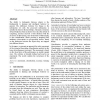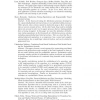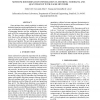284 search results - page 23 / 57 » Quantifying process equivalence based on observed behavior |
ACSW
2004
13 years 9 months ago
2004
The ability to distinguish between objects is the fundamental to learning and intelligent behavior in general. The difference between two things is the information we seek; the pr...
CORR
2009
Springer
13 years 5 months ago
2009
Springer
Abstract. We apply Uppaal Tiga to automatically compute adaptive scheduling strategies for an industrial case study dealing with a state-of-the-art image processing pipeline of a p...
AAAI
2000
13 years 9 months ago
2000
The Facial Action Coding System (FACS) is an objective method for quantifying facial movement in terms of 44 component actions, i.e. Action Units (AUs). This system is widely used...
ICIP
2001
IEEE
14 years 9 months ago
2001
IEEE
Gauss mixtures have gained popularity in statistics and statistical signal processing applications for a variety of reasons, including their ability to well approximatea large cla...
CAL
2002
13 years 7 months ago
2002
Abstract-- Computer architects must determine how to most effectively use finite computational resources when running simulations to evaluate new architectural ideas. To facilitate...



